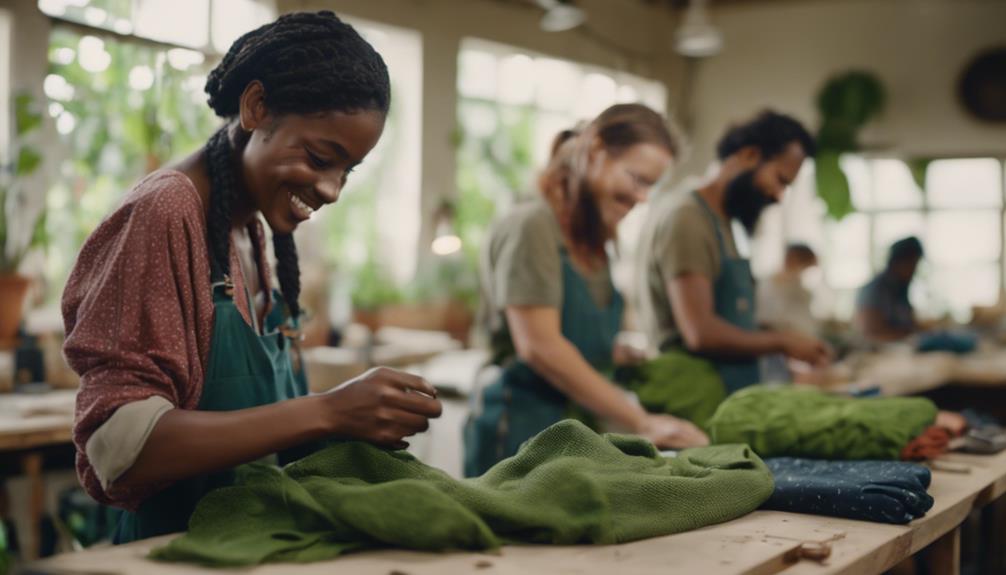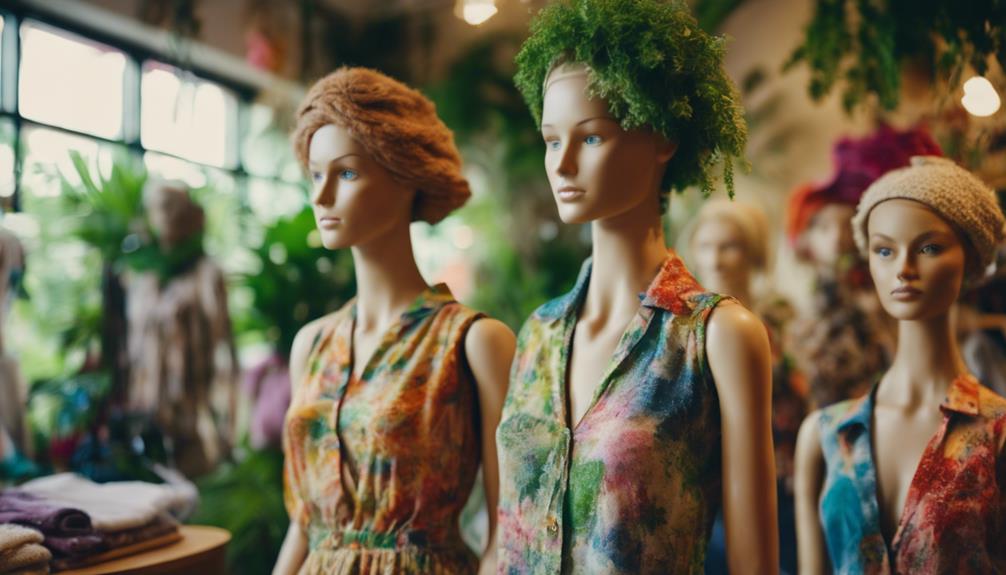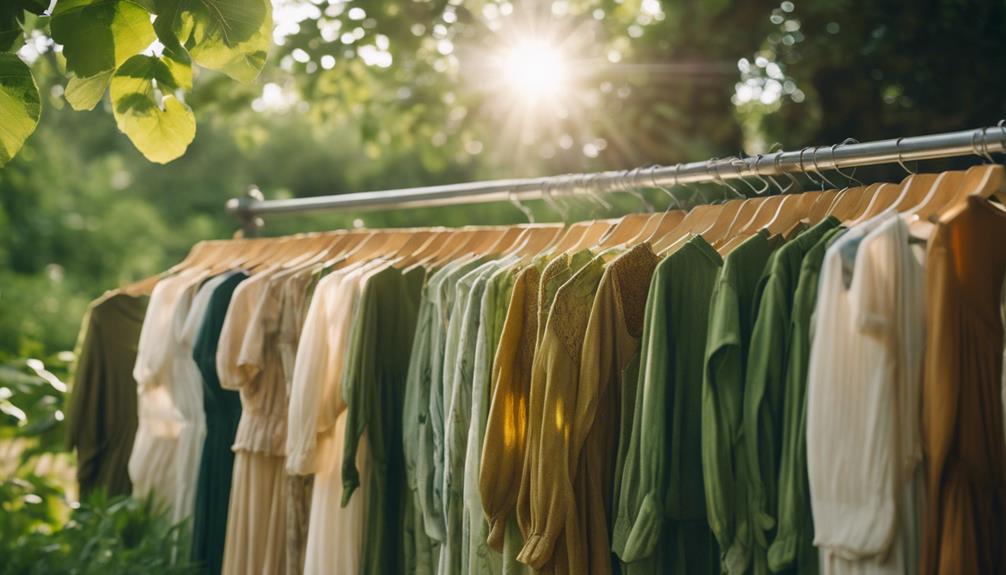Sustainable fashion brings great benefits for you and the environment. It can help you save money in the long term by using high-quality, long-lasting materials. Choosing eco-friendly options can also reduce textile waste and decrease your carbon footprint. Additionally, sustainable fashion often supports animal welfare and ensures fair working conditions for garment workers. By supporting local economies, it allows you to make healthier and more ethical choices. These advantages can enhance your style while making a positive impact. Keep exploring to discover even more surprising perks of embracing sustainable fashion! There is a sense of satisfaction in knowing that your fashion choices are contributing to the well-being of the environment and society. Embracing sustainable fashion not only benefits the present generation but also future generations by preserving resources and reducing environmental degradation. By making conscious decisions about the clothes we wear, we can help shape a more sustainable and ethical future for the fashion industry.
Key Takeaways
- Sustainable fashion promotes long-term cost savings by reducing the need for frequent replacements with high-quality, durable clothing.
- It minimizes textile waste by creating garments that last longer and support eco-friendly materials.
- Local production reduces carbon emissions and strengthens regional economies, fostering community development.
- Ethical considerations ensure safe working environments and fair wages for garment workers.
Cost Savings Over Time
Investing in sustainable fashion can save you money over time by reducing the need for frequent replacements due to its superior quality and durability.
When you choose sustainable clothing, you're prioritizing quality over quantity, which means you'll spend less in the long run.
For instance, a sustainable dress may cost £70, but if you wear it 20 times, your cost per wear drops to just £3.50.
Compare that to a £15 fast fashion dress that's worn only twice, costing you £7.50 per wear.
Superior Quality and Durability

When you choose sustainable fashion, you're investing in long-lasting materials that stand the test of time.
This not only helps reduce textile waste but also allows you to enjoy timeless designs that won't go out of style.
Long-lasting Materials
Sustainable fashion's focus on high-quality materials like organic cotton and hemp guarantees you get garments that withstand wear and tear, lasting years longer than typical fast fashion items.
With sustainable clothing, you can expect your wardrobe to be filled with long-lasting materials that offer superior comfort and durability. Instead of replacing cheap, poorly made clothes every few months, you can invest in high-quality pieces that last 5-10 years, greatly reducing overall spending.
By choosing sustainable options, you're not just saving money; you're also embracing a minimalist wardrobe. This approach encourages you to own fewer, well-crafted items rather than constantly accumulating low-quality pieces that quickly go out of style.
Additionally, opting for durable clothing helps lower environmental impacts by decreasing the frequency of purchases and the waste generated from discarded garments.
Brands like Miik prioritize these sustainable fabrics, ensuring that you receive not only stylish but also environmentally responsible clothing.
Reduced Textile Waste
High-quality, durable clothing greatly cuts down on textile waste by reducing the need for frequent replacements. When you choose sustainable fashion, you're investing in pieces made from high-quality materials designed to last. Unlike fast fashion items, which often wear out quickly and contribute to the staggering 92 million tons of textile waste generated annually, sustainable clothing offers longevity.
By opting for eco-friendly materials, you're not only supporting the environment but also minimizing the amount of textile waste that ends up in landfills. The average person discards about 37 kg of textiles each year, but with durable clothing, you can greatly decrease that number. Sustainable brands focus on creating garments that withstand wear and tear, so you'll find yourself buying less often.
Ultimately, investing in durable clothing leads to reduced textile waste and can even save you money in the long run. You'll spend less on replacements and enjoy the satisfaction of knowing your choices are better for the planet. Embrace sustainable fashion and make a positive impact on the environment by choosing high-quality, long-lasting pieces.
Timeless Design Aesthetics
Timeless design aesthetics guarantee your wardrobe remains stylish year after year, transcending fleeting trends and allowing for versatile outfit combinations.
When you embrace sustainable fashion, you invest in high-quality materials that promote superior durability. Fabrics like organic cotton and hemp not only look great but also withstand the test of time, meaning you won't have to replace them frequently.
Focusing on craftsmanship and attention to detail, sustainable brands create pieces that resist wear and tear, ultimately leading to less waste. This approach aligns perfectly with a minimalist mindset, as you can mix and match fewer garments to create a variety of outfits.
Over time, investing in sustainable fashion can yield long-term economic benefits, as each piece offers a lower cost per wear compared to cheaper, lower-quality alternatives.
Lower Carbon Emissions

When you choose sustainable fashion, you're opting for natural materials that drastically cut carbon emissions.
Local production practices also play a key role in reducing shipping emissions, making your wardrobe even more eco-friendly.
Natural Material Utilization
Utilizing natural materials in fashion not only cuts down on carbon emissions but also promotes a more sustainable and eco-friendly industry. When you choose brands that use organic cotton, hemp, or linen, you're opting for fabrics that require fewer resources and contribute to lower carbon emissions. For example, organic cotton farming can reduce emissions by up to 46% compared to conventional methods, thanks to sustainable practices that prioritize the environment.
By supporting fashion made from biodegradable materials, you guarantee that when these garments reach the end of their life cycle, they decompose naturally rather than contributing to landfill waste. This focus on natural materials not only minimizes the fashion industry's substantial environmental impact—responsible for around 10% of global carbon emissions—but also encourages a shift toward ethical consumption.
As you embrace sustainable fashion, you're playing a crucial role in reducing carbon footprints and promoting healthier ecosystems. Every choice you make sends a message that prioritizing sustainable practices and natural materials is necessary for the future of our planet.
Local Production Benefits
Choosing local production not only complements your commitment to natural materials but also greatly cuts down on carbon emissions associated with transportation. By supporting sustainable fashion brands that prioritize local manufacturing, you actively contribute to a healthier planet.
Here are some key benefits:
- Reduced Transportation Emissions: Local production minimizes the distance goods travel, considerably lowering carbon emissions that would otherwise come from shipping.
- Strengthened Regional Economies: Investing in local production supports jobs and businesses in your community, reducing reliance on global supply chains.
- Eco-Friendly Practices: Many sustainable fashion brands that focus on local production are committed to eco-friendly practices, which further decrease carbon emissions during the manufacturing process.
- Innovative Manufacturing Techniques: Local collaboration fosters innovation, leading to more efficient methods that not only benefit the environment but also enhance product quality.
Animal Welfare Protection

Sustainable fashion actively protects animal welfare by prioritizing cruelty-free materials and eco-friendly processes that minimize harm to living beings and ecosystems.
When you choose ethical clothes, you're supporting practices that reduce the negative impacts of traditional textile production. Many sustainable brands use cruelty-free materials and non-toxic dyes, which considerably lower the risk of harming animals and their habitats.
By opting for biodegradable and natural fibers, you help decrease reliance on synthetic materials that contribute to pollution and threaten wildlife. In addition, sustainable fashion mitigates the use of toxic chemicals that can run off into waterways, protecting both aquatic life and surrounding ecosystems.
Certifications like PETA-approved and vegan labels make it easier for you to identify brands committed to animal welfare standards. This means that every time you purchase ethical clothes, you're making a positive impact on the world.
By supporting sustainable fashion, you not only enhance your wardrobe with stylish, eco-friendly fabrics but also advocate for a compassionate approach to fashion that prioritizes the well-being of animals.
Embrace sustainable fashion, and you'll contribute to a better future for all living beings.
Reduced Water Usage

Fashion can consume staggering amounts of water, but by embracing eco-friendly practices, you can greatly reduce this impact. Sustainable fashion focuses on minimizing water consumption, making it an essential choice for environmentally conscious consumers like you.
Here are some benefits of reduced water usage in sustainable fashion:
- Water Recycling Practices: Many sustainable brands implement effective water recycling practices, considerably lowering the amount of water needed during production.
- Long-Lasting Materials: By investing in long-lasting materials, you reduce the frequency of purchases, which means less overall water consumption associated with clothing production.
- Non-Toxic Dye Processes: Sustainable brands often utilize non-toxic dye processes that further minimize water usage, helping to preserve this essential resource.
- Innovative Initiatives: Programs like Levi's WaterLess initiative showcase how sustainable practices can cut water consumption by up to 96% in denim finishing.
Safe Working Environments

A commitment to safe working environments guarantees that garment workers benefit from fair wages and safe conditions, fostering a more ethical industry.
Sustainable fashion prioritizes safe working conditions by adhering to strict labor laws and regulations. When you choose sustainable brands, you support practices that reduce the risks associated with hazardous environments, particularly in regions with stringent labor standards.
These brands conduct regular audits of their factories to confirm compliance with health and safety standards, promoting a respectful work atmosphere for employees. By doing so, they not only uphold labor rights but also work towards eliminating child labor and exploitation within the industry.
Certifications like Fair Trade and GOTS serve as indicators of a brand's dedication to both environmental sustainability and the well-being of its workers.
When you invest in ethical fashion, you're playing a part in creating a more equitable industry. You're helping to confirm that workers receive fair wages and that their working conditions are safe. By supporting sustainable brands, you contribute to a more responsible fashion landscape, one that values people and the planet equally.
Healthier Fashion Choices

Choosing brands that prioritize safe working environments also leads you to healthier fashion choices that benefit both you and the planet. Sustainable fashion often relies on organic materials and natural dyes, considerably reducing your exposure to toxic substances commonly found in conventional clothing.
Here are some advantages of opting for sustainable fashion:
- Reduced Chemical Exposure: You'll avoid the harmful chemicals used in traditional textile production, which can irritate your skin or lead to long-term health issues.
- Safer Certifications: Look for OEKO-TEX® certified fabrics that guarantee your clothing is free from harmful substances, promoting safer options for you and your family.
- Healthier Work Environments: Sustainable practices help create safer working conditions for garment workers, reducing occupational hazards and promoting their well-being.
- Cleaner Ecosystems: By supporting sustainable fashion, you're contributing to cleaner ecosystems, which ultimately supports better human health by minimizing pollution and its risks.
Positive Community Impact

Sustainable fashion creates a vibrant community by connecting you with local artisans and ethical brands that uplift the local economy. This approach not only supports fair labor practices but also actively combats the exploitation of workers. When you choose sustainable fashion, you're participating in a movement that prioritizes ethical and sustainable methods, ensuring that workers earn fair wages and work in safe environments.
Community involvement plays an essential role in this journey. Engaging in clothing swaps or repair cafes fosters social interaction and builds networks among like-minded individuals. These gatherings promote a sense of belonging and encourage shared values centered around sustainability.
Moreover, sustainable fashion has a positive impact on the environment, as it often uses eco-friendly materials that reduce pollution. By participating in these initiatives, you're not just making a fashion statement; you're joining a collective effort to inspire responsible habits within your community.
Together, you and your neighbors can advocate for systemic change in the fashion industry, creating a healthier environment for everyone. Embracing sustainable fashion is good for you, your community, and the planet.
Frequently Asked Questions
What Are the Positives of Sustainable Fashion?
Sustainable fashion offers you reduced carbon emissions, high-quality garments that last longer, fair labor practices, decreased textile waste, and support for animal welfare. Choosing it means making a positive impact on the environment and society.
What Are the Pros and Cons of Sustainable Fashion?
Sustainable fashion's a double-edged sword; while it promotes eco-friendly practices and social justice, it can come with higher costs and limited options. You'll need to weigh these factors against your values and budget.
Why Do People Prefer Sustainable Fashion?
You prefer sustainable fashion because it offers quality, ethical production, and environmental benefits. By choosing these clothes, you support fair labor practices, reduce waste, and connect with local artisans, making your purchases more meaningful.
Why Is Sustainable Fashion an Issue?
Sustainable fashion's an issue because the fast fashion industry creates immense waste, pollutes water, and contributes to carbon emissions. You're often caught in a cycle of overconsumption, neglecting the ethical and environmental consequences of your choices.
Conclusion
In a world where fast fashion reigns, embracing sustainable fashion feels like stepping into a modern-day Garden of Eden.
Not only do you save money over time, but you also enjoy superior quality and contribute to a healthier planet.
By choosing eco-friendly options, you're not just dressing well; you're making a statement about compassion and community.
So, why not join the movement?
With every conscious choice, you're weaving a brighter, more sustainable future for everyone.









